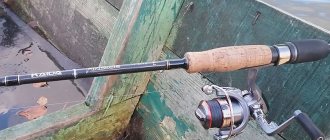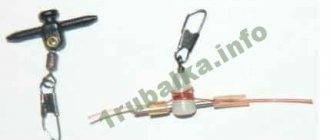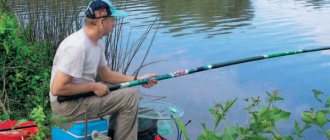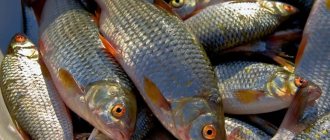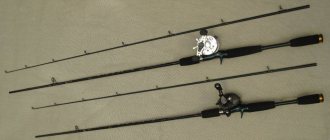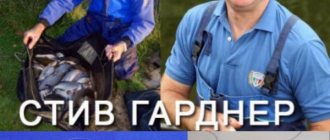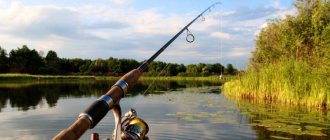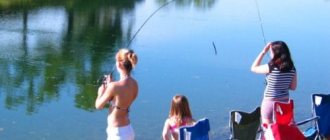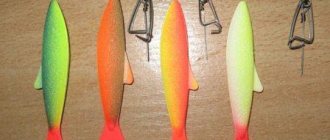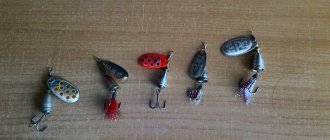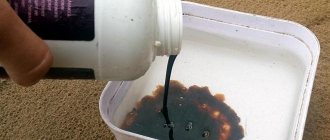A plug is a very long rod consisting of several legs that are inserted into each other, and a telescopic tip.
Indeed, the fully assembled plug seems extremely long to the average person, sometimes up to 15 meters. Such a long stick is needed to precisely reach the required fishing distance, since the bait and equipment are fed strictly under the tip of the plug.
Advantages of plug fishing:
- Excellent controllability of equipment;
- Spot and silent feeding;
- Possibility of using the thinnest equipment;
- Has a built-in shock absorber.
The built-in rubber shock absorber perfectly dampens any jerking of fish, and even powerful carp.
There is practically no fear of equipment breaking, except when using ultra-thin equipment or if a trophy bites.
The fishing area with a plug is quite limited, but at the same time, it will be more difficult for the fish to go into hiding
Let us repeat that feeding is as precise and quiet as possible, since the bait is poured into the rod using a bowl.
Review of prices for plug rods
As a rule, plug rods are represented by European manufacturers: Milo, Kolmik, Maver, Trabucco.
The most affordable and popular models today:
Maver Strong Arm 11 m. Carp plug rod. Very powerful, allows you to use 20 number tires. Weight 980 grams. Cost 26,500 rubles.
Trabucco WORLD CLASS DREAM TEAM XPS SP 11.0 m. Fully equipped. 9.5 meters main rod, extended arm, 1 kit of 4 sections, 1 powerful carp kit, mini insert, 3 tubes and a case. Weight 725 gr. Cost 31,000 rubles.
Sabaneev “TENSOR” 13 m. Rigid rod, for various types of fish. Weight 950 gr. Cost 33,000 rubles.
Plug rods for athletes can cost 250,000 rubles and more.
Plug fishing (video)
You can fish with a pole in conditions where casting with a regular fly rod is impossible, for example, due to overhanging trees.
Disadvantages of the plug
- Price – the cost of a plug rod is very high, and is often beyond the means of the average fisherman. Moreover, for normal use you need to purchase additional expensive equipment (roller, racks, platform).
- The bulkiness of the equipment and the heavy weight require you to have a car, because you won’t fit on the bus with all this.
- The fishing range is limited by the length of the plug;
- For comfortable fishing and retraction of the rod, you need a lot of space behind;
- Plug tackle is sold only in large or specialized stores; they are not sold in ordinary stores, since they are not in demand among average fishermen;
- If dirt or sand gets into the plug elbows and you fold them without cleaning, this will quickly cause them to be damaged.
Gear assembly
Fishing with a pole rod begins with the angler first installing the box and most of the accessories, in particular the recoil roller, clamping stand, whale stands, and rod holders. After this, you can begin assembling the gear. At the end of fishing, you first need to disassemble the tackle, and only then other equipment. This way you will be able to avoid troubles such as breaking the upper bend or extension cords.
Photo 3. Retractable roller.
An important element in plug fishing is the recoil roller. It is needed to move the rod while fishing and re-casting the equipment. During fishing, the fishing rod first moves horizontally, then the whale is detached, and the tackle is removed by vertically lifting the upper part. Therefore, this accessory is paramount. It must have a soft coating, preventing damage to the form, and work without jamming.
It is important to install the recoil roller correctly. When extending the fishing rod to the fishing point, at the moment its butt is torn off from this element, the center of gravity of the tackle must be in the hands of the fisherman. If you set it incorrectly, the rod will begin to “peck” up or down, leading to overlapping of the equipment, excessively tiring, and preventing you from retrieving the bait.
The clamping stand also plays an important role in the fishing process. When rolling back the form, the lower part of the fishing rod is placed under it so that the butt part does not outweigh and raise the docking point with the whale too high. Installed and adjusted after the location of the retractable roller.
As stands for whales, it is customary to use classic coils, common in fishing with a fly rod. The plug uses several supports to avoid damage to the upper elbows of the plug and to avoid clogging with dirt or sand.
The rod holder is needed to fix the tackle at the moment of fishing, when the rig is at the working point. Classic stands are used, which are easy to use and allow you to securely position the fishing rod without any extra effort.
Pole fishing equipment
For effective and convenient fishing, in addition to the rod, you will need the following equipment; not all of it is mandatory, but it greatly simplifies fishing.
- Bait cup
- Bucket for bait
- Rod holders
- Retractable roller
- Landing net
- seat
- Trap
Correspondence table (hook, line, rubber)
Bait for plug fishing
Let us repeat that it is better to feed with a plug cup, as it is more accurate and quieter. It is not always a good idea to tip the cup directly at one point, especially if you are fishing for carp or bream.
Sometimes it is worth spreading the food spot half a meter along the shore. A slightly larger bait spot attracts fish faster.
For plug fishing, you can use regular feeder bait, after wetting it and crumpling it into balls. The bait balls should disintegrate quickly. During the fishing process, you need to do regular supplementary feeding, this will keep the fish at the point.
Author of the article: Vitaly Leonidovich Ivanov, 2021.
Plug float tackle
Separately, it is worth mentioning the plug float tackle. It is used mainly by sports fishermen, but can also be useful for amateurs.
Device and principle of operation
The plug float rod consists of:
- the main part of the form, the elbows of which are connected using a telescopic or plug-in method;
- a short tip of the rod - a kit, or end cap - which is attached to the main part of the form with a plug connection; the whale itself can also be multi-part - a telescope or a plug;
- rubber shock absorber located inside the whale.
The shock absorber is a very important part of the gear. At one end of the rubber there is a fastening - a conical stopper, at the other - a connector to which the equipment is attached. The shock absorber stretches as the hooked fish jerks, working together with the blank to minimize the risk of slippage. It allows you to compensate for the lack of a reel, the friction brake of which could give up the line during strong jerks.
When casting and retrieving, a plug fishing rod moves not in a vertical plane, but in a horizontal one. To do this, you need to install a special device behind you - a sliding roller. When casting, you need to move the plug forward, moving it with your hands, so that the equipment hits the desired point. When fishing or removing the equipment from the water to recast, you need to move the fishing rod back in the same way, behind your back.
Advantages and disadvantages
Of all the float rods, the plug rod is the most effective. This is due to several factors.
This type of tackle allows you to feed the fishing spot as accurately as possible, and then also accurately feed the equipment into it. When fishing with a fly rod, Bolognese rod or match rod, such precision is not available.
Due to the fact that when fishing with a plug-in float rod, the nozzle is always located directly above the bait, the fish quickly finds the hook with the bait.
Using plug tackle, you can hold the float in one place for as long as you like, in any wind and any current strength.
The plug tackle allows you to make the fastest possible hooks.
Due to these advantages, a plug fishing rod is the best float tackle for an athlete. Amateurs rarely buy such rods, as they also have serious drawbacks.
Expensive: manufacturing a high-quality plug-in float rod requires the use of the most modern technologies and high costs.
The need to purchase additional equipment: to fish with a plug fishing rod, you will need at least a retractable roller. And also very useful for such fishing is a special platform that needs to be installed on the shore. Buying these devices requires money, and they also need to be carried with you, which is not possible or convenient for everyone.
Fishing with a plug is not possible everywhere. Not every shore is suitable for fishing with a plug-in float rod. You need open space so that you can slide a fishing rod 7, 10, 15 or more meters long behind your back.
Also, the unpopularity of plug-in float rods can be explained by the conservatism of anglers. These fishing rods are too different in their design and technique of use from traditional gear.
Types of plug-in float gear
There are 3 classes of plug fishing rods for float fishing:
- Margin poles (margin inscription on the form) are powerful gear that is designed for catching large fish. Despite the great power, they weigh little. This makes them comfortable to fish with all day long. Such a fishing rod will be the best choice for fishing in reservoirs where carp and other fish weighing over 3 kg bite, and also if there is vegetation and snags.
- Carp poles (marked carp) – designed for carp fishing. You can also use them to hunt other large fish with a fishing rod. Such gear can be quite long - up to 17 meters. The walls of the blanks of such plug fishing rods are thicker than those of Margin poles, and they weigh more. For comfortable fishing with such gear, a certain amount of physical training is required. These plug-in float rods are best suited for catching carp and other peaceful fish weighing up to 2-3 kg.
- Match poles or roach poles are universal plug fishing rods that are best suited for catching roach and other small to medium sized white fish, especially on small lakes and rivers. The standard length of such fishing rods is up to 16 m.
Weight
The weight of modern plug-in float rods is in the range of 600–1500 g. This is a very important parameter. On the one hand, the lighter the fishing rod, the more comfortable it is to fish. On the other hand, reducing weight leads to a decrease in the strength of the rod and to an increase in price.
If you are counting on catching small fish, you can take a plug fishing rod of minimal weight, which suits your cost.
If there may be trophies among the catches, it would be wiser to buy a medium-weight rod. Fishing with them will not be as comfortable as with light tackle, but the risk that the fishing rod will fail while fighting serious fish will be minimal.
Build
Fast action rods are best for catching small white fish. Using them, it is convenient to make quick sharp hooks and just as quickly pull trophies out of the water. Fishing rods designed for catching large fish usually have a slow action. Such gear well dampens the jerks of trophy specimens during fishing, which a rubber shock absorber alone might not be able to cope with.
Plug float equipment
The plug rod is equipped in the same way as conventional float tackle:
- a float is attached to the main line;
- then - several pellets, the largest at the top, the smallest at the bottom;
- a leash is crocheted.
The peculiarity of the equipment of such a fishing rod is that the length of the main fishing line, which is tied to the rubber at the end of the whale, is quite short. For comfortable fishing, the distance from the tip of the rod to the float should be 0.5-1 m.
Fishing technique
First of all, after arriving at the pond, choose a suitable section of the shore where you can sit comfortably. It is necessary that it be fairly level, and that there is an open space behind you during fishing into which you can slide the plug.
The next step is preparation for fishing. Mix the bait, lay out and place all the necessary accessories on the shore and collect the tackle.
Then select your fishing spot. To do this, hang a weight from the whale and use it to measure the depth. An edge or a local hole will be a promising place for throwing equipment.
Throw bait into the water. To do this, you can use a special whale with a cup at the end.
Now you can start fishing. Attach the main part of the form to the whale and push it forward, moving it along the retractable roller.
After biting and hooking, move the plug rod back along the roller, then remove the end cap and, holding only it in your hand, complete the fishing.
As always in float fishing, a landing net will be a good help when catching large fish on a plug. It’s more convenient to simply pull the small stuff out of the water, lifting it on the form.
